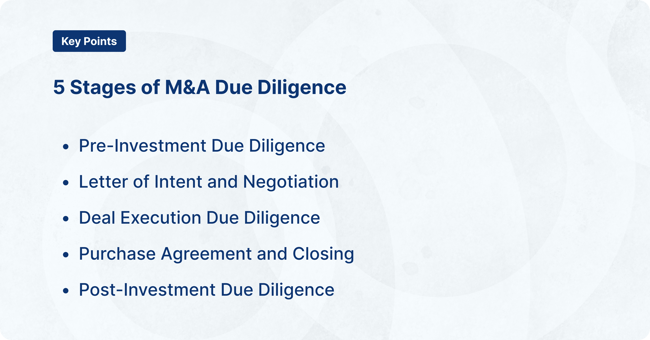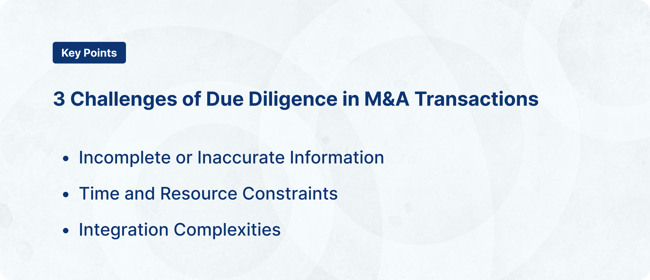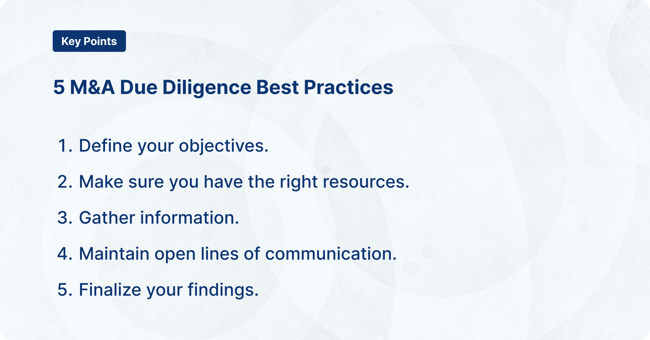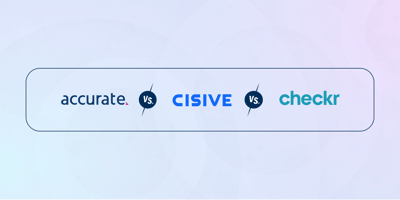

In a world where social media runs rampant, even digital footprints are considered in the hiring...

Thorough due diligence in mergers and acquisitions (M&A) helps companies verify pending deals to expand their market presence, gain a competitive edge, or otherwise grow.
M&A due diligence tells acquirers whether the target company is financially, legally, and operationally sound — and whether the deal will deliver on expectations.
This step is especially important for companies taking a “buy and scale” approach to building their businesses, as the wrong purchase can create problems that negate any expected benefits.
Learn more about due diligence in mergers and acquisitions, common challenges, and tips for executing this vital process.
Top five takeaways:
|
Due diligence is the careful examination of a target company by the potential buyer or a trusted third party. The process involves auditing the target’s operations and other risk areas, including financial statements, legal risks and liabilities, and commercial viability.
The goal is to gather all relevant information and assess potential risks or issues that could affect the deal’s success to make informed decisions. Successful due diligence gives the acquiring company the information needed to decide whether the pending deal still makes sense and aligns with its strategic objectives.

Due diligence can be subdivided into assessments of different aspects of the target company. Looking at the company’s disparate functions informs the overall view of the deal’s viability and improves your ability to spot red flags early during the M&A process.
Here are five common types of due diligence in mergers and acquisitions. Other types are emerging, such as due diligence for environmental, social, and governance factors.
Financial due diligence examines the target company’s financial health, potential risks and liabilities, and the accuracy of self-provided information.
This process requires examining the target company's financial statements, such as tax returns, profit and loss statements, income statements, accounts receivable, cash flow statements, and historical performance.
These documents can identify potential risks such as declining revenues, high debt levels, or reporting irregularities. Other areas to look at include untapped revenue opportunities, cost synergies, operational efficiencies, and the potential for post-merger profit gains.
Legal due diligence involves a thorough review of the target company's legal status and documentation. The purpose is to identify current or potential legal risks and liabilities, regulatory compliance issues, and potential obstacles to the acquisition’s success.
This process also examines the target company’s intellectual property (IP), trademarks, permits, permissions, and other key aspects.
Review contracts, compliance filings, pending and ongoing litigation, and intellectual property documentation to identify legal risks, including contract disputes or breaches.
Identify opportunities in strong legal protections, valuable IP, or potential for new market entry.
Operational due diligence evaluates the target company's operational processes, systems, and capabilities for weaknesses, potential integration challenges, and improvement opportunities.
Areas to look at include internal processes, supply chain management, IT systems, real estate and infrastructure. Operational risks include inefficiencies, dependencies, and outdated or missing technology.
Look, too, for opportunities in streamlining operations, integrating technologies, improving productivity, or expanding market reach through operational improvements.
Commercial due diligence involves analyzing the target company's market position, customer base, competitive landscape, and growth potential. This process assesses the target company's commercial viability and market attractiveness.
Conduct a thorough analysis of the target company's market position, competitive landscape, market trends, and industry dynamics. Identify risks related to market saturation, changing consumer preferences, or disruptive technologies.
Likewise, identify growth opportunities in new or emerging markets, niches, innovative products or services, or strategic partnerships.
Human resource and cultural due diligence focuses on assessing the compatibility of the target company's culture with the acquiring company's culture.
The goal is to identify cultural differences or potential clashes that could affect the integration process and overall success of the acquisition.
Assess the target company's organizational culture, talent retention, leadership, and potential conflicts that might arise because of cultural differences.
Identify opportunities for acquiring skilled talent, complementary expertise, or cultural alignment that can improve the post-merger integration process.

Due diligence in mergers and acquisitions can take weeks or months, depending on the complexity and size of the transaction. The timeline includes five key stages.
At the beginning of the process, the acquiring company does a preliminary study of the potential target. This includes collecting publicly accessible data, making a superficial analysis, and determining whether the deal appears strategically advantageous.
After the acquiring company shows interest in the target company, they offer a letter of intent. This outlines the terms and conditions of the potential transaction.
The letter of intent is nonbinding, as the target organization might accept it, reject it, seek to negotiate, or look for alternatives. When a buyer and seller sign a letter of intent, they often include clauses that facilitate due diligence, such as confidentiality agreements.
After signing the letter of intent, the acquiring company gets access to in-depth information about the target company's organizational documents, including financial records, contracts, processes, customer relationships, and more. While conducting due diligence, the acquirer can enlist external experts, such as financial advisors and lawyers.
If the due diligence process is successful and the acquiring company is satisfied with the findings, they proceed to negotiate and finalize the purchase agreement.
This contract outlines the acquisition’s terms, including purchase price, payment conditions, and other relevant contractual terms.
Once the agreement is signed, the deal moves toward closing, where the legal transfer of ownership takes place. Some deals might also require shareholder votes, regulatory approvals and, potentially, divestments.
Even after a merger or acquisition is concluded, the challenge of due diligence continues. Implement periodic and targeted rescreening of people, policies, and operations to keep your reputation clear.
Cisive offers post-investment due diligence tools to continually track a dashboard of inputs and provide clients with early warning of reputational risk, financial problems, changes in ownership, involvement of politically exposed persons, and other variables.

Every M&A due diligence process is unique, although M&A teams will face similar challenges that can be the difference between successful deals and failed transactions.
One of the main challenges in due diligence for mergers and acquisitions is obtaining complete and accurate information from the target company. The seller might not disclose all relevant details or might provide inaccurate or misleading information. These factors complicate the acquirer’s efforts to assess the deal’s true risks and value.
M&A due diligence often requires completing many complex tasks on a tight timeline, which can challenge M&A teams.
The acquirer needs to review all critical risks, even while setting priorities for the allotted window. Time constraints increase the risk of overlooking important details or making rushed decisions.
Resource constraints are another challenge and include lack of in-house M&A talent, insufficient budget, or difficulty accessing resources from the target.
A lack of resources can hamper the identification of M&A risks and increase pressure on executives to make decisions without complete information.
After the acquisition is completed, integrating the two companies can be a significant challenge. Cultural differences, incompatible technology and processes, and resistance to change are just some of the obstacles. These challenges could prevent companies from realizing the expected synergies and gains from the deal.

While every M&A due diligence process has unique aspects, there are known methods for achieving a successful transaction. Use this due diligence checklist to uncover potential issues, mitigate risks, and facilitate informed decision-making.
Begin by clearly understanding the strategic rationale behind the merger or acquisition.
Define what the acquiring company aims to achieve, whether it's market expansion, access to technology, diversification, cost synergies, or talent acquisition. Align due diligence objectives with these strategic goals to ensure that the investigation addresses critical areas.
Collaborate with stakeholders, including executives, legal advisors, financial experts, and operational teams to identify the key areas you need to examine. Prioritize each issue’s overall importance and relevance to the deal's success so you can effectively allocate resources and scrutinize the most critical aspects.
Define specific, measurable, achievable, relevant, and time-bound (SMART) goals for each area of focus. For instance, financial health is a critical concern. A sample SMART goal would be to assess the accuracy of financial statements, identify hidden liabilities, and evaluate revenue projections — doing so within 30 days.
M&A due diligence is all about having the right technology, information, and people. Start by creating a dedicated, cross-functional team — financial analysts, legal advisors, tax experts, operational specialists, IT professionals, and so forth.
In certain specialized areas (such as environmental impact assessment or patent valuation), consider hiring external consultants, such as Cisive’s advisory services team.
Make sure you have the right technology and software to perform key due diligence functions, interpret data correctly, and generate informed recommendations.
This includes data rooms, project management tools, and software designed specifically for due diligence.
Collect all relevant information about the target company, including financial statements, legal documents, contracts, and operational data.
The target company typically provides access to a virtual data room containing crucial documents.
This repository includes financial records, contracts, legal documents, IP information (such as trade secrets), employee data and operational reports. Review these documents, seeking clarification or additional information where necessary.
Schedule meetings and interviews with key personnel from the target company, including executives, department heads, and subject matter experts. Use these conversations to explore the target company’s operations, strategy, market positioning, potential risks, and growth opportunities.
These interactions provide a deeper understanding of the company and can show whether the target’s goals and documentation align with employee beliefs and actions.
Identify potential risks, liabilities, or opportunities that may affect the success of the acquisition. Involve subject matter experts, advisors, and industry specialists to provide insights and validate identified risks and opportunities in specialized areas.
Third-party experts such as auditors, consultants, or industry specialists can help provide these insights or validate findings.
Cross-verify findings from different sources and departments within the due diligence team to ensure a comprehensive understanding.
The due diligence team should regularly communicate with key stakeholders in the target company, internal stakeholders, and each other.
Regular meetings and other updates should discuss progress, share findings, and raise issues. This helps in keeping everyone informed and on track.
Encourage open dialogue for addressing concerns or queries that arise during the due diligence process. Foster an environment where anyone can raise questions or issues.
Throughout the process, document all findings, assessments, and discussions. Maintain a centralized repository that’s accessible, either directly or through reports, to relevant stakeholders.
Engage with key stakeholders involved in the M&A deal, including executives and the board. Provide updates on due diligence progress, highlighting critical findings and potential risks.
Due diligence findings should inform whether the deal moves forward, as well as how risks will be addressed — both before and after the deal is completed.
As the due diligence process nears completion, hold meetings specifically aimed at finalizing the findings. Make sure all stakeholders are present for these crucial discussions.
Completing this thorough due diligence checklist for mergers and acquisitions gives acquirers the best chance at closing sound deals that grow the company, meet regulatory requirements, and avoid undue risk.
As you go through this journey, look to external providers to help you access the expertise, databases, proprietary tools, and advanced analytics you need to make the best possible informed decisions about the parties involved. Partnering with a third party saves time and resources while improving the depth and accuracy of due diligence investigations.
Cisive’s executive intelligence division delivers actionable and targeted research to gain you competitive advantages. We have the experience and resources to help you manage traditional business dealings and expand global opportunities.
Want to learn more? Schedule a call with one of our background screening experts.

In a world where social media runs rampant, even digital footprints are considered in the hiring...

Bad hires cost businesses. The United States Department of Labor reports that hiring the wrong...

Background checks are a critical step to finding the best talent while minimizing potential risks....